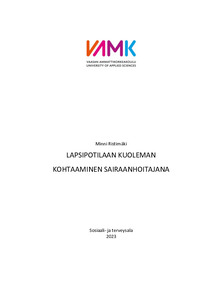Lapsipotilaan kuoleman kohtaaminen sairaanhoitajana
Ristimäki, Minni (2023)
Ristimäki, Minni
2023
All rights reserved. This publication is copyrighted. You may download, display and print it for Your own personal use. Commercial use is prohibited.
Julkaisun pysyvä osoite on
https://urn.fi/URN:NBN:fi:amk-2023100226714
https://urn.fi/URN:NBN:fi:amk-2023100226714
Tiivistelmä
Lapsipotilaan kuolema on järkyttävää, pysäyttävää ja epäoikeudenmukaista. Silti sairaanhoitajat joutuvat kohtaamaan lapsipotilaan kuoleman väistämättäkin jossain vaiheessa uraansa. Sanotaan, että lapsipotilaan kuolemaan ei koskaan totu. Tutkimuksessa selvitettiin millä tavalla sairaanhoitajat kohtaavat lapsipotilaan kuoleman ammatillisesti ja saavatko he siihen tarpeeksi tukea työyhteisöstään. Tutkimuksen tehtävänä oli luoda tutkimus, josta mahdollisimman moni nykyinen ja tuleva sairaanhoitaja saisi neuvoja ja vinkkejä lapsipotilaan kuoleman kohtaamiseen ja siitä aiheutuvan surun käsittelyyn.
Tutkimus toteutettiin laadullisena tutkimuksena ja aineistona käytettiin mahdollisimman uutta metodikirjallisuutta niin artikkelien kuin kirjojenkin muodossa. Kyselytutkimus osoitettiin Seinäjoen keskussairaalan lastenosaston, lasten päiväsairaalan ja vastasyntyneiden teho-osaston sairaanhoitajille e-lomakekyselynä. Tutkimuksen keskeisinä käsitteinä oli lapsipotilaan kuoleman kohtaaminen sairaanhoitajana, sekä kuolemasta aiheutuvan surun käsittely ammatillisesti.
Tutkimuksessa selvisi, että moni sairaanhoitajista on kohdannut lapsipotilaan kuoleman sekä moni on miettinyt sen kohtaamista etukäteen. Sairaanhoitajista suurin osa koki, että surun saa näyttää, mutta surun näyttäminen pitää pysyä ammatillisena. Moni sairaanhoitaja jää miettimään lapsipotilaan kuolemaa vielä työvuoron jälkeenkin. Sairaanhoitajat kokivat kuitenkin saavansa tarpeeksi tukea työyhteisöstään lapsipotilaan kuoleman kohtaamisen jälkeen. Perehdytystä lapsipotilaan kuoleman kohtaamiseen oli saanut vain muutama sairaanhoitaja. The death of a child patient is shocking and unjust. Yet, nurses inevitably have to encounter the death of a child patient at some point in their careers. It is said that one never truly gets used to the death of a child patient. This study aimed to investigate how nurses professionally encounter the death of a child patient and whether they receive sufficient support from their workplace community. The purpose of the study was to create research that would provide guidance and tips for as many current and future nurses as possible on how encounter the death of a child patient and cope with the resulting grief.
The study was conducted as a qualitative research, utilizing the latest methodological literature in the form of articles and books. The research questions were directed at nurses working in the paediatric ward, the children´s day hospital and in the neonatal ICU in Seinäjoki Central Hospital with an e-questionnaire. The key concepts of the study were encountering the death of a child patient as a nurse, and professionally processing the grief caused by the death.
The study revealed that many of the nurses had encountered the death of a child patient. Also a significant number of them had thought about a death of a child patient beforehand. Most of the nurses felt that it was acceptable to express their grief, but the expression of grief needed to be maintained on a professional level. Many of the nurses continued to reflect on the death of a child patient even after their shift. Yet they perceived that they received sufficient support from their workplace community after encountering such an event. Only a few nurses had received proper induction on how to encounter the death of a child patient.
Tutkimus toteutettiin laadullisena tutkimuksena ja aineistona käytettiin mahdollisimman uutta metodikirjallisuutta niin artikkelien kuin kirjojenkin muodossa. Kyselytutkimus osoitettiin Seinäjoen keskussairaalan lastenosaston, lasten päiväsairaalan ja vastasyntyneiden teho-osaston sairaanhoitajille e-lomakekyselynä. Tutkimuksen keskeisinä käsitteinä oli lapsipotilaan kuoleman kohtaaminen sairaanhoitajana, sekä kuolemasta aiheutuvan surun käsittely ammatillisesti.
Tutkimuksessa selvisi, että moni sairaanhoitajista on kohdannut lapsipotilaan kuoleman sekä moni on miettinyt sen kohtaamista etukäteen. Sairaanhoitajista suurin osa koki, että surun saa näyttää, mutta surun näyttäminen pitää pysyä ammatillisena. Moni sairaanhoitaja jää miettimään lapsipotilaan kuolemaa vielä työvuoron jälkeenkin. Sairaanhoitajat kokivat kuitenkin saavansa tarpeeksi tukea työyhteisöstään lapsipotilaan kuoleman kohtaamisen jälkeen. Perehdytystä lapsipotilaan kuoleman kohtaamiseen oli saanut vain muutama sairaanhoitaja.
The study was conducted as a qualitative research, utilizing the latest methodological literature in the form of articles and books. The research questions were directed at nurses working in the paediatric ward, the children´s day hospital and in the neonatal ICU in Seinäjoki Central Hospital with an e-questionnaire. The key concepts of the study were encountering the death of a child patient as a nurse, and professionally processing the grief caused by the death.
The study revealed that many of the nurses had encountered the death of a child patient. Also a significant number of them had thought about a death of a child patient beforehand. Most of the nurses felt that it was acceptable to express their grief, but the expression of grief needed to be maintained on a professional level. Many of the nurses continued to reflect on the death of a child patient even after their shift. Yet they perceived that they received sufficient support from their workplace community after encountering such an event. Only a few nurses had received proper induction on how to encounter the death of a child patient.
